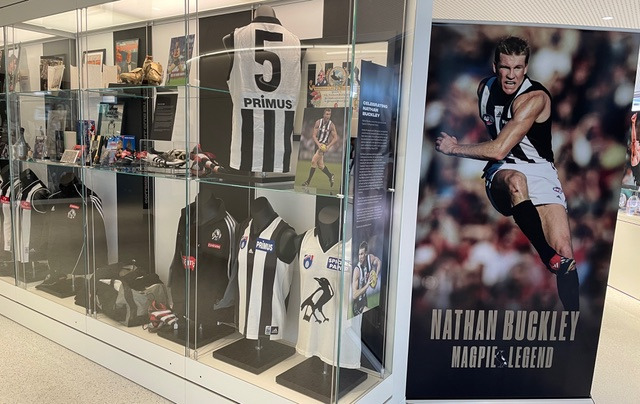CARLTON 9.15 - COLLINGWOOD 8.11 30,000 SPECTATORS
Public interest in football reached its highest point of the season on Saturday. The Carlton-Collingwood contest at Princes Oval drew a crowd of over 30,000 people and yielded a return of over ₤550. These figures are the best for one match, finals excepted, for years. The football in itself was not spectacular, and the honors went to the finest team on the day. In fact, Carlton did better in the air, handled the ball more creatively, found the open spaces more often and were superior in long kicking and in the ruck. Collingwood were fast enough to the ball - a thoroughly fit team physically - and had they finished their dashes as well as they started them, the game would have thoroughly held the crowd. The chief feature was the fighting finish by Collingwood. Although outmanoeuvred and outpaced they doggedly forced the position, and reached a stage of prospective victory, when fortune turned in Carlton's favor again.
Brown, Furnell and Cowley won applause soon after the start for fine high marking and accurate passing along the wing, which while not directly reaping a rewards in points indirectly gave Borromeo a chance, and he, with a fine drop kick, hit the post. Collingwood obtained the first goal in unusual circumstances. R. Lee secured a mark and endeavored to pass the ball on. It struck a Carltonian and rebounded into Lee's hands. The forward then ran to goals and sent it through. Furnell, a great player for Carlton, next received the ball from Canet (who marked right over his man) and scored six points.
Just later, Boromeo was calmly surveying the game from a centre forward position, and quite unexpectedly the ball came his way. He picked it up and sent it through. Canet scored another goal for Carlton in a similar manner a few minutes after C. Lee had scored for Collingwood.
Two further goals by Collingwood(R. Lee and P. Wilson) gave them the advantage in points for the quarter. The figures were with Collingwood, but Carlton's merit in the general work stood out.
The play in the second quarter was a little more attractive from the spectators point of view, but individually Carlton were in the main superior. Cowley scored for them by receiving the ball from Furnell, who had marked grandly. Saunders was very safe full back for Collingwood, and his kicking in was very fine. Lee, marking almost on the goal line, placed his team ahead again, but a goal by Cowley, which finished the quarter, gave Carlton a 7 point advantage at halftime.
It must have been as amazing to the players of Collingwood as it was to their supporters, to find the team so much astray in handling the ball, and in endeavoring to play it to advantageous positions. There was the nip in their play, but not the finish.
In the third quarter they were not again seriously in the game until after Fisher and Furnell had scored goals for Carlton. Interest was on the wane, but a revival of it set in when Collingwood came with a fine series of rushes. C. Lee hit the post with one shot, but Wraith found the opening with a beautiful left-foot kick. Just later R. Lee missed a running chance, and C. Lee, who marked the kick in from the resultant behind, found the distance too far. Scohie was seen in effective defence. Misfortune for Collingwood did not stop there. R. Lee was within distance, but the chance went when he endeavored to play the ball on. He scored a behind, and later on missed again, while Wraith also failed. All these incidents occurred during the last twelve minutes of the quarter. There was a touch of real Collingwood play, save for the forward work, in the runs referred to, and with only 11 points to the bad, and a noticeable improvement in play, Collingwood reckoned on making a good finish of it.
They did, but practically all along Carlton's superiority was manifested. Cowley scored a goal for the Blues, and then another Collingwood score occurred. Pannam and Seddon each scored goals, making the scores 8.15 to 8.9, in Carlton's favor. The capping point was a goal by Downs ten minutes before the finish for Carlton. After that, Carlton well held their own.
Furnell and Downs were Carlton's best men. McGregor (centre), McDonald and Scobie (back), Boromeo (following), Dunn (who kicked in well), Canet (wing) and Daykin (forward), were other prominent players. O'Brien was an absentee.
Collingwood's full back, Saunders, was about the most consistently good player, and his kicking was fine. Wilson was as active as ever, roving, but was not as effective as usual. Dobrigh (half-back), Drummond and Twomey (wings), Reynolds (following), Laxton (roving), and Mutch (half back), were the best of the others. All the players, however, were more or less astray in handling the ball and passing it on.
1919 'FOOTBALL.', The Age (Melbourne, Vic. : 1854 - 1954), 16 June, p. 10, viewed 22 September, 2015, http://nla.gov.au/nla.news-article155204836






